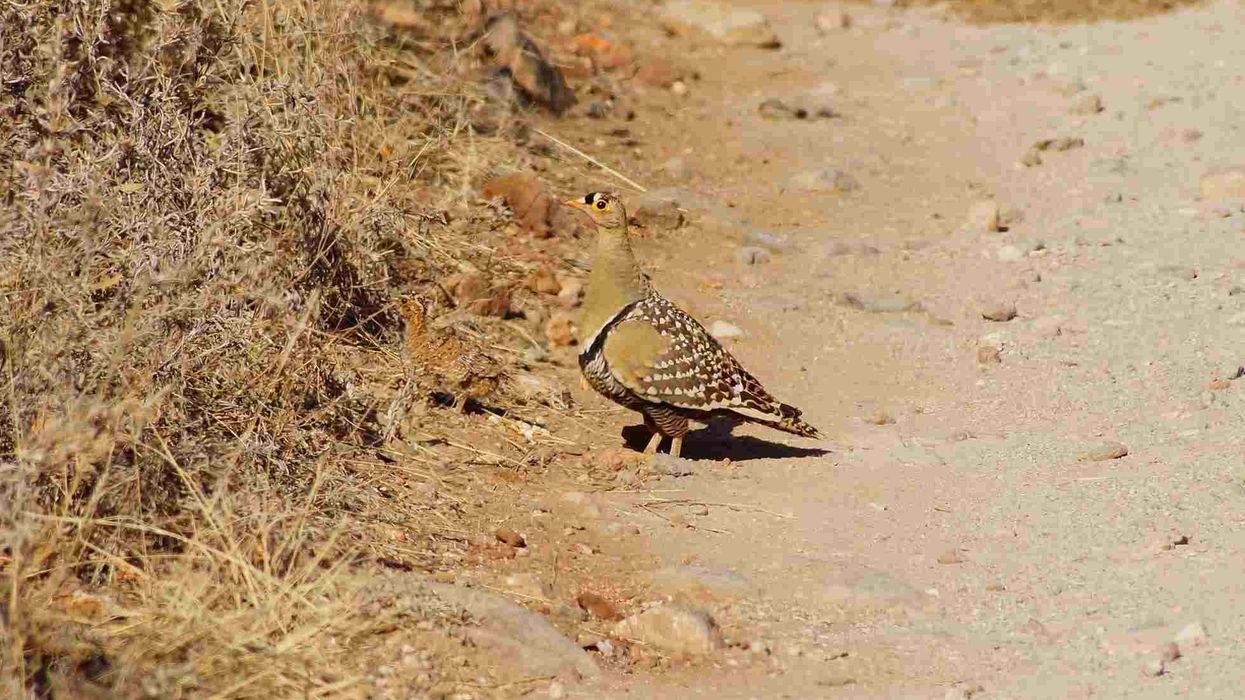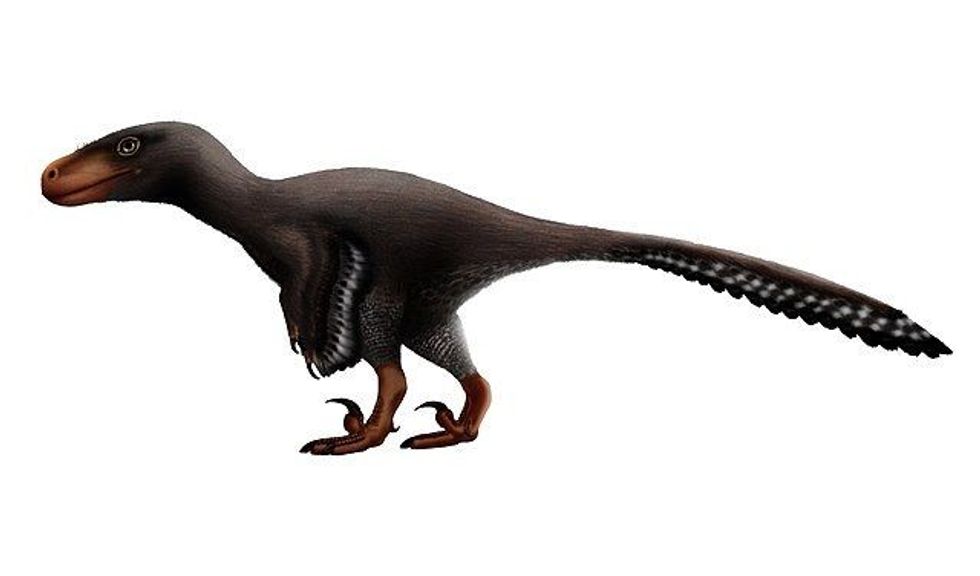The Namaqua sandgrouse (Pterocles namaqua) is a medium-sized bird species that is mainly found in South Africa. It is a ground-dwelling bird that belongs to the family Pteroclidae and the order Pterocliformes. This species is also found in Zimbabwe, Namibia, Angola, and Botswana. It is common in the western cape regions and the Kalahari desert.
Its habitat includes arid regions in the southern parts of Africa. It prefers land with thin grass and succulent plants. Their diet consists of fruits, nuts, seeds, and insects as they are omnivores.
The conservation status of the species is of Least Concern according to the IUCN as these African birds are abundantly present in their native habitats. However, they are threatened by predators like mongooses.
Their life span is from five to eight years. The most notable feature in this species is that the male soaks its belly feathers in water to quench the thirst of its chicks. Chicks then drink it using by squeezing their little beaks into the male's feathers.
You can also check out interesting facts about other birds species such as greater sage grouse facts and leghorn chicken facts.
Namaqua Sandgrouse Interesting Facts
What type of animal is a Namaqua Sandgrouse?
Namaqua sandgrouse is a bird species in the sandgrouse family that is usually found in South Africa. This bird belongs to the order Perciformes.
What class of animal does a Namaqua Sandgrouse belong to?
Namaqua sandgrouse belongs to the class Aves and phylum Chordata.
How many Namaqua Sandgrouse are there in the world?
The population size of Namaqua sandgrouse has not been estimated yet but is quite common in the southern parts of Africa.
Where does a Namaqua Sandgrouse live?
Namaqua sandgrouse (Pterocles namaqua) distribution can be found in numerous arid regions of South Africa and its neighboring areas. It is a common bird in the Kalahari Desert, some Western Cape regions, and the Nama Karoo (in central and western South Africa).
This South African bird also lives in Zimbabwe, Angola, Botswana, and Namibia (particularly in the Namib Desert).
The Namaqua sandgrouse range map distribution extends to Spitskop Nature Reserve in the Northern Cape, the Tankwa Karoo National Park, the Karoo National Park, and the Benfontein Nature Reserve near Kimberley, where it can easily be observed. Interestingly, it also thrives in various parts of the Old World, including Europe, Africa, India, China, Mongolia, and the Middle East.
What is a Namaqua Sandgrouse's habitat?
The Namaqua sandgrouses' habitat range of distribution can be found mainly in southern Africa. It prefers to live in deserts, semi-desert, and other arid regions.
It can easily be seen in the lands with short, thin grass, succulent plants, and scattered shrubs. Although, it is also found in heavily wooded fry savannahs. This bird can live only on seeds, sand gravel, and water.
It will fly larger distances over the desert for water. When a watering source dries up, it flies with bigger flocks until a new water source is found. Its habitat generally has coarse vegetation and some tussock-type grasses.
In the Kalahari desert, the Namaqua sandgrouse's habitat also includes sandy savannahs with ticker vegetation. They are strong birds that can survive the harsh weather of southern Africa.
Who do Namaqua Sandgrouse live with?
Namaqua sandgrouses live alone, in pairs or groups (flocks).
How long does a Namaqua Sandgrouse live?
In the wild, the maximum life expectancy of the Namaqua sandgrouse is between five to eight years.
How do they reproduce?
Breeding in Namaqua sandgrouses takes place all the year and is mostly dependent on rainfall. During this season, the sandgrouse is a monogamous bird, which means a single Namaqua male mates with a single female.
Nests are built by rubbing on the ground, usually in a small plant's shade. The nests are lined with pieces of vegetation or stones.
One pair generally makes its nest in solitary, but sometimes numerous pairs of birds select sites near each other. Female sandgrouse lays two to three eggs at a time which are long with brown spots.
During the daytime, the female incubates the eggs, while the male sandgrouse incubates the eggs during the night hours.
The male starts incubating their eggs around two hours past sunset and finishing two hours after dawn and their chicks hatch after 21-23 days. To avoid attracting predators like jackals and foxes, Namaqua Sandgrouse eggshells are carried away from the nest by one of the parents.
As chicks become independent after hatching, they feed on their own. However, the male parent does give water to the young by absorbing water from watering holes in his belly feathers and flying back to the nest.
Chicks have feathers by the age of three weeks and can fly from the nest after four to five weeks. Their diet consists of insects, fruits, seeds, and nuts.
What is their conservation status?
These birds are considered to be a common species among its distribution range and therefore considered to be of Least Concern by the International Union for Conservation of Nature (IUCN) Red List of Threatened Species.
However, these birds are at risk of predation from various predators, including booted eagles, snakes, mongooses, falcons, peregrines, and jackals. Mongooses love to eat the eggs of these birds.
In protection, the sheep farmers usually kill the predators to protect their flocks which ended in an escalation in the mongoose population and, as a result, a reduction in the population of sandgrouse chicks that survive.
Namaqua Sandgrouse Fun Facts
What do Namaqua Sandgrouse look like?

It is a medium-sized bird with a stout body, short legs, and a small head that shuffles awkwardly on the ground. Their total body length can reach about 11 in (28 cm) long, with a bodyweight of around 6.34 oz (180 g).
Male birds are more colorful with an orange buff head, chest, and throat outlined by a distinct linear band of white and dark brown. The upper body and wings are mottled brown with big white spots.
There are two long black filaments stretching from the olive-brown tail. The pattern and coloring of the female birds and juveniles are more hideous, being generally different shades of brown. Interestingly, only the birds in South Africa possess a long and pointed tail.
Their wingspan is between 19.68-20.47 in (50-52 cm). As these birds are sand-colored, they can easily hide in the background.
There are feathers on the legs and toes of these birds. Some have little feathers while some have feathers all over their legs and toes.
How cute are they?
Namaqua sandgrouses are moderately cute birds that are fun to watch.
How do they communicate?
Namaqua sandgrouse birds communicate through a far-carrying call which is a musical 'kelkiw-wyn'.
How big is a Namaqua Sandgrouse?
The Namaqua Sandgrouse's length is 11 in (28 cm), which is four times smaller than a crested pigeon.
How fast can a Namaqua Sandgrouse fly?
The flying speed of the Namaqua sandgrouse (Pterocles namaqua) has not been estimated yet.
How much does a Namaqua Sandgrouse weigh?
The average weight of the Namaqua sandgrouse (Pterocles namaqua) is around 6.34 oz (180 g). They are 10 times bigger than the cardinal bird.
What are the male and female names of the species?
There are no specific names for male and female Namaqua sandgrouses.
What would you call a baby Namaqua Sandgrouse?
The Namaqua sandgrouse baby is generally known as a chick.
What do they eat?
The Namaqua sandgrouse diet mainly consists of seeds, leaves, flowers, and fruits. This species also feeds on insects like earthworms, giant water bugs, worms, and mollusks.
These birds consume seeds with a tiny amount of pebbles and gravel that help them to break down the hard seeds in the stomach. They forage in the sand with their beaks flipping the sand left and right in quest of seeds.
Are they dangerous?
No, these birds are not dangerous at all. In fact, they are cute and friendly poultry birds.
Would they make a good pet?
Yes, they are beautiful birds that would be suitable to keep as pets. In addition, they do not require high maintenance to raise them.
Did you know...
As Namaqua sandgrouses live in desert areas, they usually forage for food during the cooler hours of the day.
How does a male Namaqua Sandgrouse get water to its chicks?
The Namaqua sandgrouse(Pterocles namaqua) lives in harsh conditions with a low number of watering holes in southern Africa. To satisfy the thirst of its chicks, the male brings water by soaking its belly feathers into the water and then comes back to the nest.
Chicks drink water by sucking the feathers of their father.
It sounds unbelievable and amazing but the male usually flies up to 2o mi (32.18 km) to get 0.9 fl oz (25.5 ml) of water (about two tablespoons). Alternatively, adults drink directly from the watering holes.
Difference between a male and female Namaqua Sandgrouse?
The male has a black and white band across his chest with some orange buffs, while the female lacks these features. In general, females have a lighter coloration while males have a darker coloration.
Here at Kidadl, we have carefully created lots of interesting family-friendly animal facts for everyone to discover! Learn more about some other birds from our blue grouse facts and mountain chickadee facts pages.
You can even occupy yourself at home by coloring in one of our free printable Namaqua sandgrouse coloring pages.









